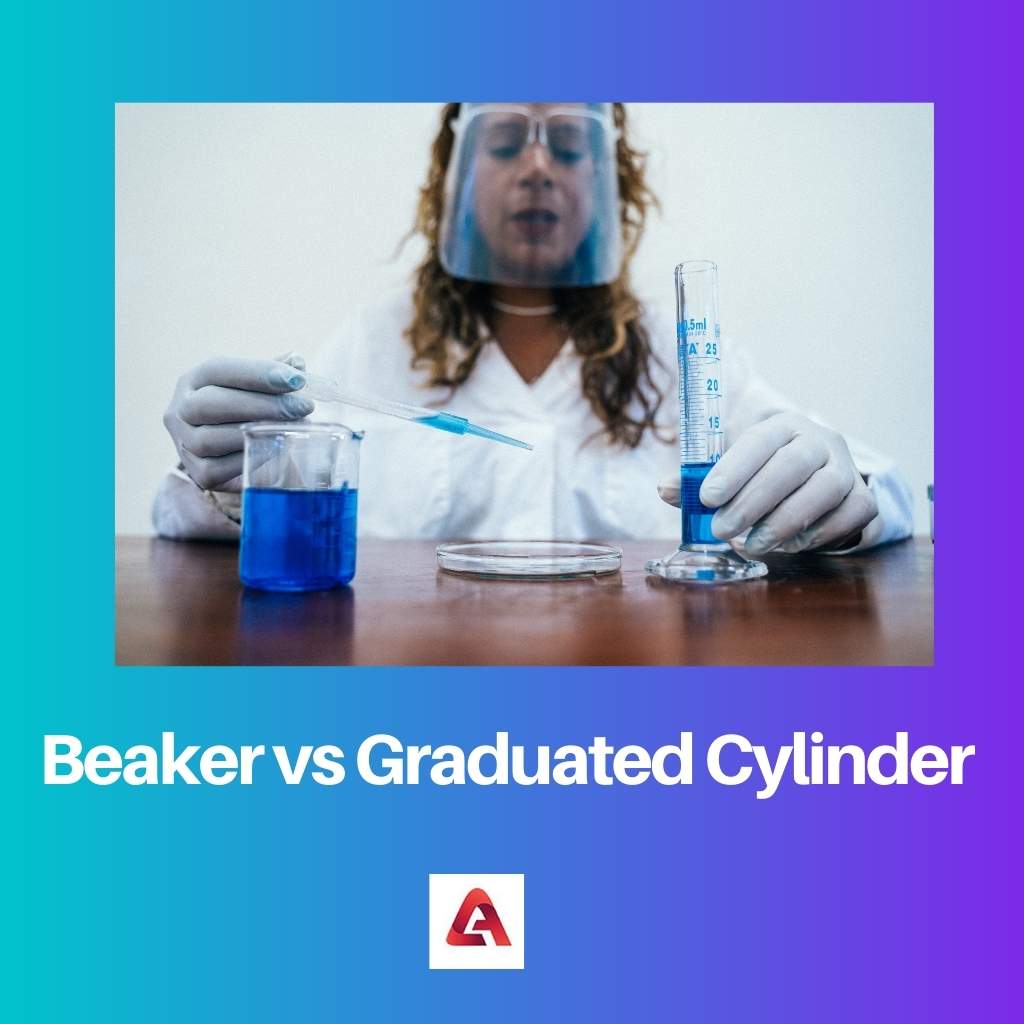Beakers and Graduated Cylinders are both apparatuses used to experiment smoothly in a laboratory. These apparatuses can withstand both high temperatures and corrosive chemicals, making them ideal for use in experiments involving chemical and biological analyses.
Even though both Beaker and Graduated Cylinders have some similar features, they differ significantly from one another.
Key Takeaways
- Beakers are cylindrical containers for mixing and heating liquids, while graduated cylinders are used for precise volume measurements.
- Graduated cylinders have markings indicating volume, while beakers have approximate volume markings.
- Beakers come in various sizes and shapes, while graduated cylinders have a tall, narrow shape for accuracy.
Beaker vs Graduated Cylinder
A beaker is a cylindrical container with a flat bottom and a pouring lip. It is used for holding and mixing liquids. It has markings on the side for rough volume estimations. A graduated cylinder has a narrow, cylindrical shape with vertical graduations on the side that indicate precise volumes.

A beaker is a cylindrical container used as an apparatus in a laboratory to transport and mix solutions. They are made using glass or any particular type of plastic.
The Beaker resembles a coffee mug and provides an accurate measurement of the liquid inside the container. Even though beakers have a wide mouth and a flat bottom, they are available in different sizes.
A graduated Cylinder is a narrow-shaped apparatus used in a laboratory for measuring the volume of liquids. They are also marked to show the level of the fluids. They are made using materials like polymethylpentene or polypropylene.
Graduated Cylinders act as more accurate laboratory apparatuses in terms of measuring liquids. The instrument is similar to that of a measuring cup.
Comparison Table
| Parameters of Comparison | Beaker | Graduated Cylinder |
|---|---|---|
| Definition | A Cylindrical container is used as an apparatus in the laboratory to transport and mix solutions. | Narrow-shaped apparatus used in a laboratory for measuring the volume of liquids. |
| Materials used | It is made using glass or any other type of plastic. | It is made using materials like polymethyl pentene or polypropylene. |
| Purpose | Used for the purpose of transporting and mixing solutions. | Used for the purpose of measuring the volume of liquids. |
| Shape | Cylindrical in shape. | Narrow-shaped. |
| Pouring lip | Has a small pouring lip. | Has a spout to make the pouring of solutions easier. |
What is Beaker?
A Beaker is a cylindrical container used as an apparatus in a laboratory to transport and mix solutions. It resembles a coffee mug without a handle that has been graduated for accurate liquid measurement.
In general, beakers are constructed from glass or any other type of plastic. They also have markings outside denoting the approximate amount of liquid inside. Although beakers lack lids, they can be covered using a watch glass or a larger beaker.
Beakers are, however, less accurate than Graduated cylinders. They have a small pouring lip to make the transporting and mixing of liquid easier. Even though beakers have a wide mouth and a flat bottom, they are available in different sizes.

What is Graduated Cylinder?
A Graduated Cylinder is a narrow-shaped apparatus used in a laboratory for measuring the volume of liquids. The volume of an object can be determined by taking a reading before inserting it into the graduated cylinder and then measuring the difference between the two readings afterwards and using the result to determine its density.
In general, Graduated cylinders are constructed out of materials like polymethyl pentene or polypropylene. This is because polymethyl pentene helps to make the container transparent, less fragile, and lightweight.
On the other hand, polypropylene helps the container maintain its high level of chemical resistance. The Graduated Cylinders consist of a spout to make the pouring of solutions easier.
Graduated Cylinders act as more accurate laboratory apparatuses in terms of measuring liquids. It resembles a measuring cup and likely is marked to show the level of the fluids.

Main Differences Between Beaker and Graduated Cylinder
- A Beaker is a cylindrical container used as an apparatus in a laboratory to transport and mix solutions. On the other hand, a Graduated Cylinder is a narrow-shaped apparatus used in a laboratory for measuring the volume of liquids.
- In general, beakers are constructed from glass or any other type of plastic. On the other hand, Graduated cylinders are constructed out of materials like polymethyl pentene or polypropylene.
- The beaker resembles a coffee mug without a handle that has been graduated for accurate liquid measurement. On the other hand, resembles a measuring cup and likely is marked to show the level of the fluids.
- Beakers are mainly cylindrical with a flat mouth and wide bottom. On the other hand, Graduated Cylinders are mainly narrow-shaped.
- Beakers mainly have a small pouring lip, whereas Graduated Cylinders have a spout for easy pouring of solutions.


I found the information to be quite helpful and very detailed.
The article clearly explains the difference between Beakers and Graduated Cylinders. It provides a great understanding of these apparatuses.
The content of the article is clear and beneficial.
Yes, it is very helpful.
Good information, but a bit repetitive at times. Overall very informative and useful.
I agree Jgraham, the article does repeat itself sometimes.
Yes, but overall it is a valid and useful article
The article stated some interesting facts about Beakers and Graduated Cylinders. Very informative.
I think so too.
Yes, it was a good read.
Very educational. It is a useful reference for people who are not familiar with laboratory apparatuses.
The article made the key difference between Beakers and Graduated Cylinders clear.